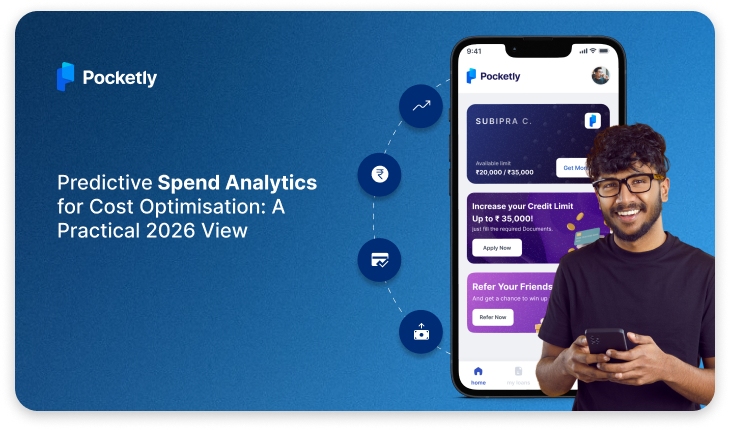
Life can be unpredictable, especially when you’re juggling studies, work, and trying to make the most of your youth.
You’re about to start your final year of college, and suddenly, your laptop crashes—right when you need it most for assignments and projects. It’s not like you can wait until the end of the semester to replace it, and your savings are already stretched thin with other expenses. What do you do?
This is where short-term finance comes in handy. It’s like having a safety net for those moments when life throws a curveball. Whether it’s covering the cost of a new laptop, paying for that unexpected bill, or even funding a spontaneous weekend trip, short-term financing options can give you the quick boost you need.
In this guide, we’ll explore the different types of short-term finance available to help you navigate these situations with ease. Let’s get started!
What is Short-term Finance?
Short-term finance is like your financial backup plan when you need cash fast but don’t want to be tied down for too long. Imagine it as a quick fix for your money needs, whether it’s for covering unexpected expenses, managing everyday costs, or seizing a sudden opportunity that requires a little extra cash. Typically, short-term finance means borrowing money that you’ll need to pay back within a year.
This could be anything from using a credit card, taking out a small loan, or even dipping into an overdraft. The key thing to remember is that short-term finance is all about quick access to funds with the understanding that you’ll repay it sooner rather than later. It’s a handy tool for managing your finances without committing to long-term debt.
Example: Imagine you’re planning a trip with friends, but your paycheck is still a week away. You could use a short-term loan to cover the cost of booking flights now, knowing you’ll pay it off as soon as your salary hits your account. This way, you don’t miss out on the trip, and you’re not stuck with a long-term debt.
Short-Term Sources of Finances you can Avail
Short-term sources of finance play a pivotal role in supporting your budget. Below is a comprehensive list of the common options available designed to provide flexibility for handling day-to-day challenges:
1. Trade Credit: Buy Now, Pay Later
Trade credit is like the ultimate trust game in the business world. It’s when a supplier allows you to take the goods or services you need now but pay for them later. This can be a real lifesaver when you’re waiting for some cash to come in but need to keep things moving.
How It Works:
- Delayed Payment: You receive the goods or services immediately but have a set period, typically 30 to 90 days, to pay the supplier.
- Typical Credit Period: The supplier might give you 30 to 90 days to make the payment, depending on the agreement.
Example: Imagine you’re running a small café, and you need a bulk order of coffee beans and pastries to get through the next month. Your supplier might offer you trade credit, allowing you to take the stock now and pay them back once you’ve sold enough lattes and croissants. This way, you keep your business running without worrying about upfront costs.
2. Bank Credit: A Financial Safety Net
Bank credit is like having a financial safety net that you can tap into whenever you need extra funds. This could be through loans, cash credit, overdrafts, or even discounting bills. Banks offer these services to help you manage your finances more flexibly.
Types of Bank Credit:
- Loans: You borrow a specific amount from the bank and agree to repay it over a fixed period with interest.
- Cash Credit: The bank sets a withdrawal limit that you can access whenever needed, without a strict repayment schedule.
- Overdraft: You can withdraw more money than you have in your account, up to a certain limit.
- Discounting of Bills: The bank advances you the money by discounting your bills of exchange or promissory notes, providing you with immediate funds.
Example: Let’s say you’re a young entrepreneur who’s just started a tech company. You need to purchase some high-end computers and software, but your savings aren’t quite enough. You could take out a short-term loan from the bank to cover the costs, knowing you’ll repay it once your business starts generating revenue.
3. Short-Term Loans: Quick and Convenient
Short-term loans are borrowed funds that you’re expected to repay within a year. They’re ideal for when you need quick cash to cover an immediate expense but don’t want to be tied down by long-term debt.
How It Works:
- Borrowed Funds: You borrow money with the understanding that it will be paid back within a year.
- Quick Repayment: These loans usually come with higher interest rates because of the short repayment period, but they’re a good option when you need funds fast.
Example: Picture this—you’ve just launched a tech startup, but you need a new server to handle the growing traffic to your website. You take out a short-term loan to purchase the server, knowing you’ll pay it off once your customer base expands and your revenue increases.
4. Commercial Paper: Quick Funds for Big Players
Commercial paper is a type of unsecured, short-term debt instrument that’s typically used by large corporations to meet their immediate financial needs. This is a common practice among big companies because it allows them to raise funds quickly without putting up collateral.
How It Works:
- Unsecured Debt: Companies issue commercial paper as a form of debt that doesn’t require collateral, making it a straightforward way to raise money.
- Short-Term Maturity: The debt usually matures within 270 days, meaning it must be repaid in less than a year.
Example: Imagine a large manufacturing company that needs to purchase raw materials to meet a surge in demand. Instead of taking out a traditional loan, the company issues commercial paper to quickly raise the funds necessary to buy the inventory. This allows the company to keep production running smoothly without waiting for long-term financing.
5. Factoring: Turn Receivables into Ready Cash
Factoring is a financial arrangement where a business sells its receivables (amounts owed by customers) to a third party, known as a factor, at a discount. This method is particularly useful for businesses that need immediate cash and don’t want to wait for customers to pay their invoices.
How It Works:
- Selling Receivables: You sell your outstanding invoices to a factoring company, which gives you a percentage of the invoice value upfront.
- Immediate Cash: In return, the factoring company collects the full payment from your customers, providing you with instant cash flow.
Example: Let’s say you run a textile manufacturing business and have sold a large order of fabrics on credit. Instead of waiting 30, 60, or 90 days for payment, you sell the invoice to a factoring company and get most of the money right away. This helps you pay for materials and labor without waiting for the customer’s payment.
6. Customers’ Advances: Funding Before Delivery
Customers’ advances are payments made by customers before the delivery of goods or services. This method is often used by businesses to finance the production of goods or to secure necessary resources for a large order.
How It Works:
- Advance Payments: Customers pay a portion of the total cost upfront, which the business uses to finance the production or purchase of goods.
- Business Financing: This advance helps the business manage cash flow and production costs without dipping into its own reserves.
Example: Imagine you’re a manufacturer who has received a large custom order for machinery. The customer pays an advance to secure the order, which you then use to purchase the materials and start production. This way, you don’t have to wait until the entire order is fulfilled to cover the costs.
These short-term financing options offer businesses the flexibility and immediate cash flow needed to maintain operations, especially when timing is crucial.
Also if you need any quick access to funds without the hassle of long-term debt, Pocketly offers a fast and flexible solution. Whether it’s for a business need or a personal expense, Pocketly can help you get the cash you need—right when you need it.
Also Learn: Getting Personal Loans Without Documents or Income Proof
Now, let’s explore the benefits of short-term financing, especially for businesses and young adults needing quick funds or better cash flow management.
Benefits of Short-Term Sources of Finance
1. Quick Access to Funds
- Speedy Availability: One of the primary advantages of short-term finance is the speed at which you can access funds. This is crucial whether you're a business needing to cover unexpected expenses or a young adult facing an urgent financial need.
- Example: If you're a young adult needing a small loan to cover an emergency car repair, or a business owner looking to purchase materials for a sudden order, short-term loans or credit options can provide the necessary funds quickly.
2. Flexibility in Financing
- Adaptable Solutions: Short-term finance offers a range of flexible options, from trade credit to personal loans, allowing you to choose the method that best suits your immediate needs.
- Example: A young adult might use a short-term loan to manage unexpected expenses like a medical bill, while a business could opt for factoring to convert outstanding invoices into immediate cash flow.
3. Lower Overall Costs
- Cost-Effective: Since short-term financing typically involves borrowing for a shorter duration, the total interest paid is usually lower compared to long-term financing.
- Example: A young adult might take a short-term loan to cover a shortfall until the next paycheck, minimizing interest costs. Similarly, a business can use a short-term loan for a project lasting a few months, reducing the overall interest paid.
4. Helps Maintain Cash Flow
- Cash Flow Management: Short-term finance helps both businesses and individuals maintain a healthy cash flow, covering gaps between income and expenses to ensure smooth operations.
- Example: A small business might use a bank overdraft to manage payroll during a slow season, while a young adult might use a short-term loan to cover rent during a temporary financial crunch.
5. Boosts Creditworthiness
- Builds Credit History: Regularly using and repaying short-term finance can help build a strong credit history, which is beneficial whether you’re running a business or managing personal finances.
- Example: A young adult who successfully repays a series of short-term loans can build a solid credit score, making it easier to secure favorable terms on future loans. Similarly, a business can improve its creditworthiness by consistently managing short-term debt.
Short-term finance offers crucial benefits for businesses and young adults alike, providing the flexibility needed to navigate both personal and professional financial challenges.
Now, let get to know what and how can Pockely help you cover your short term finance needs:
How Pocketly Can Help Cover Your Short-Term Finance Needs
When you’re in a tight spot and need quick cash, Pocketly is your go-to solution. Whether you’re a student facing unexpected expenses or a young professional managing tight budgets, Pocketly offers a trouble -free way to cover your short-term financial needs.
1. Instant Access to Funds
- Quick Approval: Get the money you need fast, with a simple and quick approval process.
- Perfect for Emergencies: Whether it’s a surprise bill or an urgent purchase, Pocketly has you covered.
2. Flexible Loan Options
- Tailored to Your Needs: Choose the loan amount and repayment period that works best for you.
- Easy Repayment: Manageable repayment terms to fit your financial situation.
3. No Hidden Fees
- Transparent Terms: Pocketly prides itself on transparency, so you’ll never have to worry about unexpected charges or hidden fees. What you see is what you get, making it easier for you to plan and manage your repayments.
4. Build Your Credit Score
- Improve Financial Health: Timely repayments can help build or improve your credit score, setting you up for future financial success.
5. User-Friendly Experience
- Simple and Convenient: Pocketly’s app is easy to navigate and quick to use, making borrowing stress-free.
With Pocketly, handling your short-term financial needs is simple and straightforward. Whether for emergencies, special purchases, or bridging the gap until payday, Pocketly gives you the support you need, when you need it.
Conclusion
Managing your finances can be challenging, especially when unexpected expenses pop up or you need a little extra help to make it through the month. That’s where understanding short-term finance options comes in handy—they give you the flexibility to handle life’s surprises without too much stress. And with Pocketly, managing your short-term financial needs becomes even simpler.
Pocketly offers a straightforward, reliable way to access the funds you need, right when you need them. Whether it’s covering a sudden expense or helping you stay on top of your budget, Pocketly is designed to be your go-to financial tool.
Why wait? Download Pocketly today and take the next step in making your financial life easier and more manageable.
FAQs
What is short-term use of finance?
Short-term use of finance refers to the allocation of funds to meet immediate financial needs or obligations within a short period, typically less than a year. This includes covering operational expenses, managing cash flow, or addressing unexpected costs.
What are the short-term sources of finance?
Short-term sources of finance are financial instruments or resources used to meet short-term funding requirements. These include trade credit, bank credit, short-term loans, commercial paper, factoring, and customer advances, all of which provide quick access to funds to cover immediate needs.
What are short-term sources of finance at the A level?
At the A level, short-term sources of finance refer to methods that businesses use to fund their operations in the short term. These methods include trade credit, where suppliers allow delayed payment; bank overdrafts, which allow businesses to withdraw more money than they have in their accounts; and short-term loans, which are loans to be repaid within a year.
How does Pocketly ensure a hassle-free borrowing experience?
Pocketly offers a seamless borrowing experience with a fully digital application process, transparent terms, and flexible repayment options. The app is designed to be intuitive and easy to navigate, making the entire loan process—from application to repayment—stress-free and straightforward.
What is a guide on types of short-term sources of finance?
A guide on types of short-term sources of finance provides an overview of the various financial options available for meeting short-term funding needs. It explains the characteristics, benefits, and drawbacks of each source, helping businesses and individuals make informed decisions about which type of finance best suits their immediate requirements.
How do businesses typically use short-term finance?
Businesses use short-term finance to cover immediate expenses such as payroll, inventory purchases, and other operating costs. It helps manage cash flow and ensures that the business can continue to operate smoothly without disruptions.
How does Pocketly make accessing short-term finance easier?
Pocketly simplifies the process of accessing short-term finance by offering a user-friendly app that allows you to apply for loans quickly and easily. With minimal documentation required and fast approval times, Pocketly ensures you get the funds you need when you need them most.
Can Pocketly help if you need instant cash for an emergency?
Absolutely! Pocketly is designed to provide quick access to funds in emergency situations. Whether it's an unexpected medical expense or an urgent purchase, Pocketly’s fast disbursement process ensures you have the cash on hand to handle the situation without delay.
What are some common examples of short-term sources of finance?
Common short-term sources of finance include trade credit, bank overdrafts, short-term loans, commercial paper, and factoring. These options are typically used by businesses and individuals to manage cash flow needs over a brief period, usually less than a year.
Why is short-term finance important for businesses and individuals?
Short-term finance is crucial for managing day-to-day expenses, covering unexpected costs, and maintaining smooth operations. For businesses, it helps in managing working capital and seizing growth opportunities. For individuals, it provides quick access to funds for urgent needs or temporary financial shortfalls.















